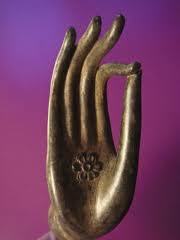The mantra I was just reading about is Om Namah Shivaya, probably the most famous (?).
ॐ नमः शिवाय
I read a bit more about what it means after a bit of chanting that I unknowingly got myself into the past couple Thursday evenings in an Anusara mixed levels yoga class that completely, 110% empowers me. Just ask Natalie and Alice because I could not shut up about it last Thursday, and the Thursday prior, Natalie got an SMS from me exclaiming that I can do anything in the world. Anyway, I embraced the OM, finally, and it was because the whole "song" (what is it called when a mantra is sung?) that my favourite Michael Lau leads us in for Anusara class. There is a lot more to it, but it does start off with "Om Namah Shivaya" and then follows a bit about gratitude to your teachers, their teachers, and their past teachers, and so on.
Essentially, the mantra, if you break it down, represents the elements that govern the chakras, such as earth, water, fire, air, and earth. Then each piece of the sounds contained in the mantra mean something as well. They each represent a part of our "body" (referred to as mayakosa in Sanskrit). For example, "Na" refers to the whole physical body (also referred to as annamayakosa). The "ma" component refers to the prana or energy (pranamayakosa), "Shi" or "Chi" refers to the mental acumen (manonmayakosa), "va" refers to the intellect (vignanamayakosa), and "ya" refers to the blissful body (anandamayakosa). Again, the "OM" or perhaps more importantly, the silence beyond the sounds of the three syllables that make up the "OM" refers to the soul or the life within oneself.
But what does this all mean? Apparently I'm not the only one who finds the ideas behind this mantra hard to interpret.... but it has been done and is perhaps what most closely resonates with me the most broad, most general, and most appropriate for me:
Peace and salutations to that which I am capable of becoming.


